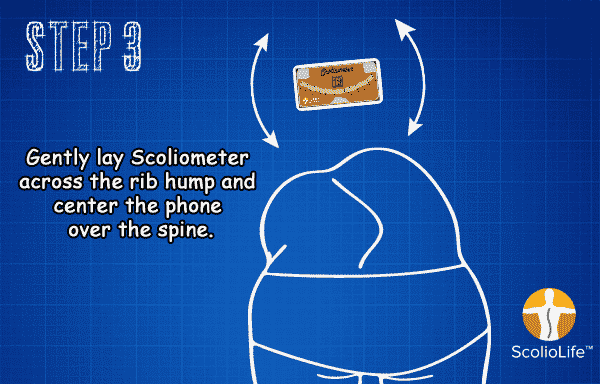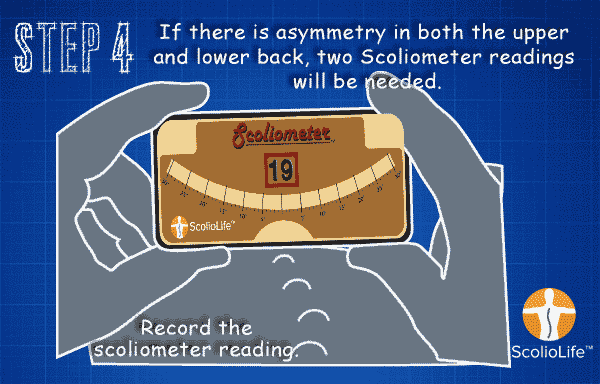How to Use
the Scoliometer
Step by Step
Instructions




Take advantage of ScolioTrack Pro by finding answers to the most frequently asked questions.
Scoliosis was originally a Greek word meaning curved or bent. Today it is a word used to describe the most common type of spinal curvature. Scoliosis is simply a descriptive term, like headache, and not a precise diagnosis.
When a scoliosis develops the spine bends sideways and rotates along its vertical axis. These changes have cosmetic and physiological effects with long-term consequences which may result in significant health problems with severe curves.
ScolioTrack integrates the benefits of a scoliometer which measures the Angle of Trunk Rotation (ATR) and tracks the person’s height, weight and postural changes.
An Scoliometer measures distortions of the torso. The patient is asked to bend over, with arms dangling and palms pressed together, until a curve can be observed in the thoracic area (the upper back). The Scoliometer is placed on the back and used to measure the apex (the highest point) of the curve. The patient is then asked to continue bending until the curve in the lower back can be seen; the apex of this curve is then measured.
The test for scoliosis screening is simple. Most parents are capable of doing the screening test with a high degree of accuracy. The standard test for scoliosis is termed the Adam’s Forward Bend Test. Kids are asked to bend over at the waist as if they were touching their toes. The examiner gets their eyes level with the back and looks for one side being higher than the other, or any asymmetry of the back. Even parents with no medical training can detect relatively small curves if they look carefully.
It is advisable to track a child’s scoliosis at least two times a month. This is because scoliosis most commonly occurs during the adolescent growth spurt.
Adults can track their scoliosis once a month to monitor degenerative or age-related changes.
The generally accepted guideline is to refer when the scoliometer reads 7°. Recently studies have shown that scoliosis is increasingly being missed in obese children. In some cases, scoliosis that measures over 40° presents with a scoliometer reading of only 7° in an obese child. Therefore, refer overweight children with the scoliometer reading of 5°.
A HEALTH CARE PROFESSIONAL SHOULD BE CONSULTED IMMEDIATELY IF IN DOUBT.
The management options for scoliosis fall into three main categories: observation of the scoliosis, non-operative therapy and surgical.
The date in ScolioTrack is based on the phones the settings in Region Format.
Setting Region Format:
Settings > General > International > Region Format
Choose the region you currently live in.
Updates may cause loss of data. Please backup or record your results before installing a new version.
If you were charged for ScolioTrack by Apple iTunes after purchasing a subscription within the ScolioTrack app on your phone and would like a refund, you must contact Apple or Google directly, as they do not provide us with the ability to process refunds. Only Apple or Google customer support can process refunds for purchases made through their App Stores account.
ScolioTrack is a safe and innovative way to track a person’s scoliosis condition month-to-month by using the iPhone or Android accelerometer just as a doctor would with a scoliometer. It also tracks a person’s height, weight and postural assessment as well making it the most comprehensive scoliosis tracking software in the world.
An Scoliometer measures distortions of the torso. The patient is asked to bend over, with arms dangling and palms pressed together, until a curve can be observed in the thoracic area (the upper back). The Scoliometer is placed on the back and used to measure the apex (the highest point) of the curve. The patient is then asked to continue bending until the curve in the lower back can be seen; the apex of this curve is then measured.
Scoliosis is a three-dimensional condition which involves not only a sideward bending of the spine but also rotation. ScolioTrack as well as the traditional Scoliometer measure this twisting of the spine.
Please watch the tutorial video where Dr. Kevin Lau walks through the features and functions of ScolioTrack himself found inside the app in the MORE page. On this page click the top left button labelled “Play Tutorial”.
Research suggest that patients with a 5° scoliometer reading have an 11° scoliosis, and patients with a 7° scoliometer reading are likely to have a Cobb Angle of 20°. Refer to a physician with a scoliometer reading of 5° or greater if they are not already under observation.
For monthly increases of five along with postural changes using the posture assessment tool in ScolioTrack then refer to your health professional for a review.
Remember to bring along your ScolioTrack to show the physician your records.
Go to your doctor if you notice signs of scoliosis in your child. Mild curves can develop without you or your child knowing it because they appear gradually and usually don’t cause pain. Occasionally, teachers, friends and sports teammates are the first to notice a child’s scoliosis.
ScolioTrack supports multi-lingual versions.
We currently serve in English, French, German, Greek, Italian, Indonesian, Portuguese, Russian, Finnish, Swedish, Spanish, Japanese, Chinese (Simplified and Traditional), Vietnamese, Thai, and Korean.
The language is automatically selected based on the iPhone’s language. The language of ScolioTrack can be changed through the iPhone’s settings.
Setting the language:
Settings > General > International > Language
Choose the language you want to use, and tap Done.
Once you purchase an application, you can download it without charge.
Application update is a new release that can be purchased or downloaded through App Store on iPhone or Android device App Stores.
There may be times when you accidentally delete a purchased app before you get a chance to back up your purchase. See the steps to re-download your App Store purchase.
In this case, you can re-download what you have purchased previously through your phones App store.



